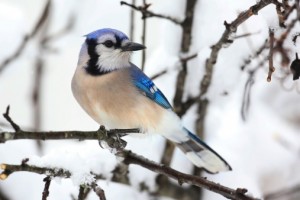 Bright blue and spritely, the Blue Jay is a bird that graces our Adirondack landscape year-round, making its home mainly in deciduous, acorn-laden forest areas. Sometimes considered pesky because of their noisy calls and their alleged robbery of eggs and nestlings, not everyone finds the Blue Jay to be the beautiful bird it is. What is known about this brilliant blue songbird with the perky crest is that it is highly social, intelligent and has much more to it than may meet the eye. The Cornell Lab of Ornithology has studied this family-oriented bird, and below are a few facts about their discoveries that may make you change your mind about the Blue Jay.
Bright blue and spritely, the Blue Jay is a bird that graces our Adirondack landscape year-round, making its home mainly in deciduous, acorn-laden forest areas. Sometimes considered pesky because of their noisy calls and their alleged robbery of eggs and nestlings, not everyone finds the Blue Jay to be the beautiful bird it is. What is known about this brilliant blue songbird with the perky crest is that it is highly social, intelligent and has much more to it than may meet the eye. The Cornell Lab of Ornithology has studied this family-oriented bird, and below are a few facts about their discoveries that may make you change your mind about the Blue Jay.
Blue Jays, scientifically known as Cyanocitta cristata, are North American birds that are found throughout all of the Eastern and Central United States. They are known for their radiant blue coloring coupled with a white underbelly and heavy black markings, accented by the large crest atop their heads. They are visually stunning, and their call is equally striking and recognizable – most often, people hear their loud, unmistakable “jeer” sound, accompanied by gurgling and whistling. Blue Jays also frequently mimic the hawk, which brings us to the next point – their intelligence.
Blue Jays are smart birds and are known for their complex social system. They mate for life, with their mate generally staying with them throughout the year, and within their family they have close bonds. Blue Jays in captivity have been able to imitate human speech patterns, as well as sounds from some other animals, like cats. They have a variety of vocalizations compared to other birds, leading researchers to believe they have an extensive “vocabulary.” Additionally, Blue Jays use body language when communicating with other birds, such as elevating or lowering their crest depending on individual situations. Captive Blue Jays have also been observed building and using tools from newspaper to obtain seed from outside their cage.
As far as migration for the Blue Jay is concerned, this largely remains a mystery to researchers. Some Blue Jays stay in their range year-round, living in the deciduous or coniferous tree they call home. Younger Blue Jays tend to migrate more than adults, but adults migrate as well. Some vary their migration patterns year after year, staying north for one year and then going south one year. All tolled, less than 20 percent of Blue Jays migrate, and those that do, do so unexplained – researchers have yet to figure out their migration patterns.
For those who don’t like Blue Jays, one of the main reasons cited is that they raid the nests of other birds, eating eggs and sometimes nestlings. While this is somewhat true, it should be noted that it is far less common than believed. Researchers studying Blue Jay feeding habits found that only one percent of the birds studied had evidence of eggs or nestlings in their stomachs. For the most part, these birds had ingested insects, nuts, fruits and acorns, their food of choice. In fact, Blue Jays are often dominated by other bird species, such as Woodpeckers, Grackles, Bobwhites, Doves, Mockingbirds and Cardinals, as well as animals like squirrels and chipmunks. The Blue Jay, therefore, is often all boisterous call, no peck!
If you’d like to attract the beautiful, brilliant Blue Jay to your backyard, here are a few tips you might follow. Install a tray feeder or post feeder rather than a hanging feeder. Fill it with such delicious treats as peanuts, sunflower seeds and suet. Consider planting a couple of oak trees, which will yield a home for the Blue Jay as well as their favorite delicacy, the acorn. A savvy multi-tasker, your Blue Jay population will not only enjoy a dip in your birdbath on a warm summer day, it will enjoy taking drinks as well, so keep your birdbath full of clean water to attract more birds.
To learn more about the Blue Jay and many other of the Adirondack’s avian dwellers, visit the Cornell Lab of Ornithology at https://www.birds.cornell.edu/.
